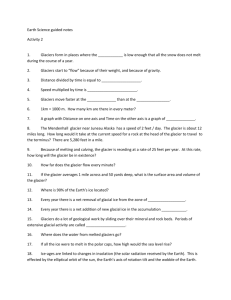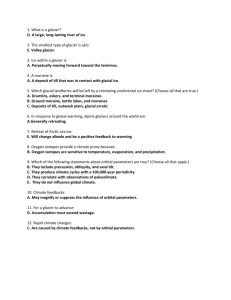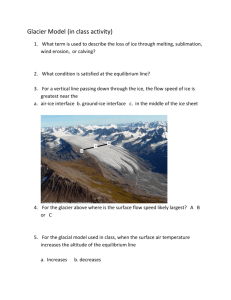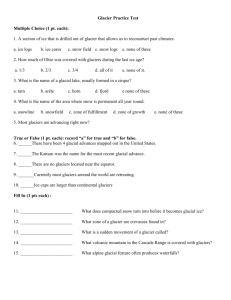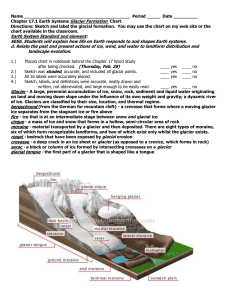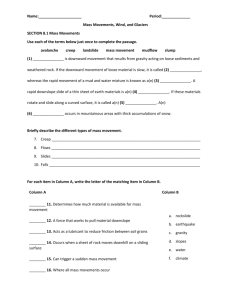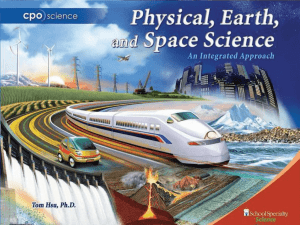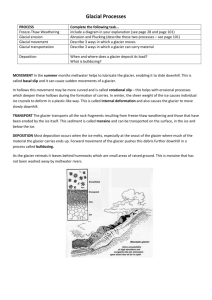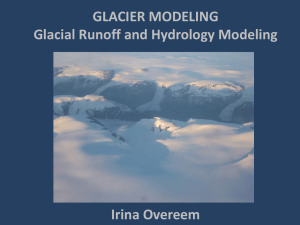Report
advertisement
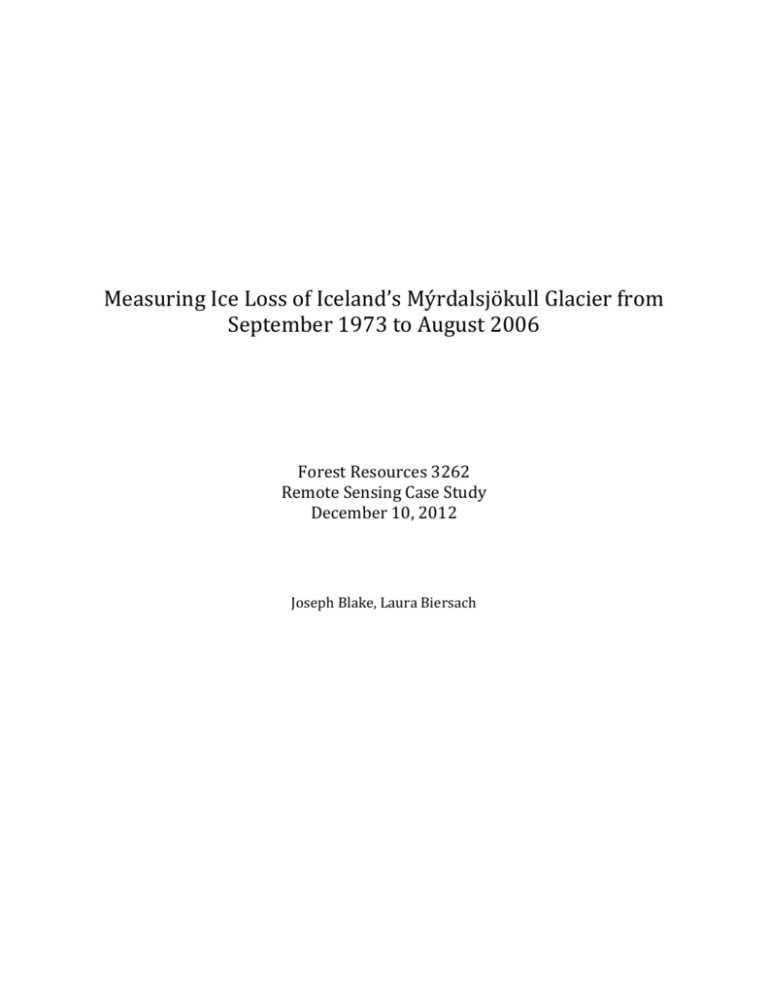
Measuring Ice Loss of Iceland’s Mýrdalsjökull Glacier from September 1973 to August 2006 Forest Resources 3262 Remote Sensing Case Study December 10, 2012 Joseph Blake, Laura Biersach Objective: The objective of our remote sensing project is to determine if the Mýrdalsjökull glacier in southern Iceland is melting. If it is melting we want to determine the amount of ice that has melted between two data sets that are separated by more than 30 years. Introduction and background: Iceland is an island in the North Atlantic Ocean, 753 miles from the west coast of Greenland and 1370 miles to Europe. Iceland has an area of 39,768 square miles and 3,088 miles of coastline. It was buried under ice during the last ice age and still has 13 glaciers of varying sizes. The interior of Iceland is mostly an elevated plateau with small areas of forest and even smaller areas suitable for agriculture. The northern region of the country is extensive grasslands used for sheep and cattle. Historically sheep were one of Iceland’s main exports. Due to this fact they cut much of the standing timber in the country (which is already a small percentage) and caused severe erosion. Now that they know the damage heavy grazing has created, conservationists are continually trying to plants cover species and reestablish natural and exotic tree species to stabilize the soil. Iceland sits in a unique spot. It is found on the Mid Atlantic Ridge which separates four tectonic plates. The Mid Atlantic Ridge is a mountain range in Atlantic Ocean extending from Northeast Greenland to South Africa. Most of this ridge is underwater but some areas, like that in Iceland, extend above sea level. Iceland sits on the ridge separating the North American Plate and the Eurasian Plate. These plates are constantly moving away from each other; the North American Plate moving east and the Eurasian Plate moving west. These plates are separating at a rate three millimeters per year. Over the last 10,000 years the rift has separated by 230 feet and sunk by 131 feet (Strickland, 2010). The Mid Atlantic Ridge changes the geography of the island and also is the cause of Iceland’s volcanic activity. Iceland has one of the most geographically active places on Earth and has approximately 200 volcanoes and 35 of them are still active. On average there is a volcano eruption every 5 years ("Geology of iceland,"). Soils with the parent material of volcanic ash are extremely sensitive to change and erosion. Their nutrients are depleted quite easily if not properly managed. In addition to volcanic eruptions, hot springs, geysers, and earth quakes are common. Our area of focus was Mýrdalsjökull; 63° 40’ N., 19° 06’ W. It is the southernmost glacier on the island. At its highest point it is 4,898 ft. tall, the ice is hundreds of feet thick and roughly covers 260 square miles. Mýrdalsjökull is a glacier that is actually covering the upper portion of the large volcano, Kalta. It is positioned directly over Kalta’s caldera. A caldera is the depression a volcano makes when it erupts. The volcano empties its magma when it erupts; when it is finished it can collapse forming a steep bowl shaped depression ((How volcanoes work:). Kalta is known to erupt every 40 to 80 years. Since 930 it has erupted 16 times. It is connected to several other volcanoes and regarded as one of the most powerful in the world. Before the construction of a highway system south of Mýrdalsjökull, people feared traveling the plains. Not only is Mýrdalsjökull covering a volcano, but it also experiences major flooding events. These events come rather unexpectedly despite heavy scientific observation. The source of these glacier runs comes from meltwater that flows into depressions in the glacier, the depressions get deeper and deeper and expand into nearby depressions. Any activity within the volcano can release the stored water. In addition to the stored water, the heat from the volcano melts ice situated under the ice gap. These combined effects maximize the destruction. These massive flooding events are called jökulhlaups ("Katla valcano,"). Jökulhlaups have been known to flow as fast as 400,000 meters squared per second. In comparison, during its rainy season, the Amazon River only flows 2 meters squared per second. That is an incredible difference (Carrvick, J.L, 2011). Jökulhlaups leave little in their wake as they rush their way to the ocean. It is normal for glaciers to melt. They have been melting since the last ice age 22,000 years ago. Glaciers either break off into chunks creating icebergs (that melt even faster) or melt directly into rivers or the ocean. Sea water is constantly evaporating and constantly being replaced by melting glacier water. The issue that has arisen within the last century is the amount of ice melting from the glacier to replenish the sea isn’t balanced to the reduced amount of snow that is accumulating. Thus the glacier is sinking in size at the same rate the sea-level is growing. With that in mind the excess fresh water will change in temperature and salinity of the ocean which in turn changes the water density. The water density would throw the balance of the ocean currents out of alignment creating even more changes to the climate. Methodology: Data collection: When deciding where to get our data we had to think about what our main goal was and what we wanted to accomplish. Since we are comparing glacier images and how they may or may not have changed, we needed data that stretched between significant time periods; data that was from 20 years ago that would be similar to data taken more recently. We decided that for mapping glaciers, it would be good to have about 30m resolution. High resolution data, collected from commercial satellites didn’t make sense because we wanted to look at an entire glacier that could be hundreds of square miles. Data from satellites such as IKONOS can accurately get very close to specific objects but it was not needed to accomplish our goals. 250 meter Modis data was also disregarded. The data collected from these satellites is not specific enough, in our project we wanted to get an accurate measure of glacial ice over a couple hundred square miles, whereas Modis data can map the entire country. For these reasons we decided that data from the Landsat satellites would be a perfect fit. Landsat data has 30m resolution. With this data we would be able to see our entire study area and could map out the glacier fairly easily. Data from Landsat is also free to the public through the United States Geological Survey’s website. To kick off our project we needed to start looking on the USGS Glovis website for an area we thought would be a solid study area. We initially started our search in Greenland. Greenland proved to be a difficult area to find a good study area. The entire landform of Greenland is a glacier. It has separate peaks and names for different areas, but they all mass together making it impossible to see specific boarders. We downloaded the data but found it to be non-useable. After discussing our problem with some fellow classmates they suggested looking elsewhere. One of the suggestions was Iceland where the glaciers are much more distinct and separated. In the end we chose Mýrdalsjökull, a glacier on the southernmost portion of the country. Once we located the glacier using the Glovis, we knew this would work well because the entire glacier fit perfectly into one swath width. Almost immediately we ran into trouble. Our initial plan was to use data from the late 1980’s and data from the late 2000’s. Many of the images that we would have liked to use had heavy cloud cover. We had said that anything over 20 percent would make it too difficult. With 20 percent cloud cover we could still distinguish the white glaciers from the white clouds. We also wanted to measure the change between summer and winter within a one year period, data from the 1980’s and again for a more recent image. This however brought us back to the issue we saw in Greenland’s data. It was all white and indistinguishable. We decided to stick with summer data from the two dates and make our comparisons. We ended up finding a great image from the original Landsat, Landsat 1, for September 1973 and an image from August 2006 using data from Landsat 7. On May 31, 2003 the scan line corrector failed causing all images taken after that point to have streaking lines and missing data. Our data from 2006 has this effect. We decided that the scan line error and the few clouds in the image could be dealt with because it was the only image that was an option close to present time. Once our images were unzipped and downloaded we began the next step which is pre-preocessing. Pre-Processing: The first thing we did to get our data ready for classification was a layer stack operation. The layer stacking took a lot of time. Erdas, the remote sensing program that we were working with would unexplainably lock up or shut down losing all of the information that we were trying to find. Finally we were able to complete this step resulting in the stacking of our two images with different types of multispectral data. We than clipped our images down to the size of our desired study area. This was done to save the computer program processing time when we classified and to save room on the flash drive. We decided that no normalization, geographical correction, or atmospheric correction would be needed for our project since our images would perform a classification satisfactory. We linked views between the 1973 image and the image from 2006 and used a inquire curser to see if our images needed to be geographically corrected. They did not because the curser was in the same place on both images. With that complete we could now begin classification. Classification: We chose to go with unsupervised classification since we were only interested in two classes (ice and no ice). Unsupervised classification is also recommended for areas you are unfamiliar with. These two classes were very easy for the system to figure out in our 1973 image. However it was more difficult for the 2006 image. The Augu1973 st 2006 image has slight cloud cover over a non-ice area in the image that, with only 2 classes, saw the clouds as ice. In order to fix this problem we went back through and changed the number of classes from two to four. The system was then able to give us a great classification for the 1973 image and a bunch better classification for the 2006 image. When the classification was done we made an attribute table. This table represented the amount of pixels that the computer placed in the four classes. In the 1973 image had 3, 412,189 pixels. The 2006 image had 48,397,584 pixels. You can see this represented in table 1 of the appendix. We thought that the pixel numbers would match up and we could calculate the amount of loss by comparing the two. When they weren’t comparable we remembered our data was from separate satellites. The September 1973 image came from Landsat 1, the satellite was launched on July 23, 1972 and terminated on January 6, 1978. The August 2006 image came from Landsat 7 which was launched on April 15, 1999. It is still functioning but as stated previously, the scan line corrector in Landsat 7 failed in May 2003. The problem with using these different satellites is that many advances have been made to the technology. Landsat 1 was equipped with Multispectral Scanner System (MSS) which had 4 spectral bands, 6-bit radiometric resolution, and 79 meter spatial resolution. Landsat 7 uses Enhanced Thematic Mapper Plus (ETM+) this has 5 spectral bands, 8-bit radiometric resolution, and 30 meter spatial resolution. The two images would make it difficult to map the glacier’s differences using the Erdas program. Change Detection: We could however use the pixels to figure out our percent change in Excel. This was done based on how many pixels were classified as ice and non-ice from 1973 to 2006. For nonice or dry land in 1973 there was 39.6%. In 2006 there was 40.4%. This resulted in a .8% change. For melted ice in 1973 image there was 9.6% and in the 2006 image there was 7.9%. This resulted in a 1.7%. The soft ice in the 1973 image was 9.6%. The 2006 soft ice was 12%. This is a 2.4% change. For 1973 the ice percentage of 41.3% in 2006 the percent was 39.7%. The percent change is 1.6%. This can be seen in table 2 of the appendix. We expected to see a greater percentage change for dry land in the 2006 image, however we did not. This was due to the fact that much of the dry land was classified as glacier due to cloud cover. Also in the 1973 image classification some of the soft and melted ice were classified as dry land. It was reassuring to see that there was indeed change between the images. However we wanted to know exactly how much ice had melted in miles squared. In order to do this we uploaded our data into ArcGIS. We made polygons around the September 1973 image and around the August 2006 image. From there we created attribute tables for both images to calculate area. We found that in 1973 there was about 304 square miles of glacier. In 2006 there was about 266.5 square miles of glacier. That is a total loss of 37.5 square miles over the 33 year period. That is a 12 percent change. Using the polygons we were only able to classify what was ice and what was not ice. So in this case we classified soft, medium, and ice into one main ice category. You can see the differences in figure 5 of the appendix. Because of this we are unable to determine the amount of ice in square miles for each category as we determined the percentage previously. Accuracy Assessment: To begin our accuracy assessment we chose to use random points. We did not feel that using a different point layout would increase the accuracy. In each image we placed 65 random points. The error matrix was able to tell us that the 1973 image was 96% accurate and the 2006 image was 75% accurate. This can be seen in table 3 of the appendix. For reference data, we used our Landsat images because other accurate images were not acquirable for our dates. Results and Discussion: After completing our classifications, change detection, and analysis of our data a loss of ice from the glacier was clearly seen and quantified. As stated above there was a 12% and 37.5 square miles loss of glacier mass over the 33 year time period. On average there is 1 square mile lost per year. We would expect that to intensify as time goes on. This is due to increased average temperatures, decreased snowfall, and as the glacier gets smaller it will melt faster because it has less overall mass. With our results you can clearly see that there is a significant change to Iceland’s Mýrdalsjökull glacier spanning the time gap. However we did encounter limitations. In an ideal situation we would have liked to use data from one satellite. The two satellites are very different and increased the difficulty of our change detection. Since Landsat 7’s scan line corrector failed the quality of images drastically decreased. We also would have liked to use images that didn’t have cloud cover. When we classified our image the unsupervised classification misclassified the clouds as glaciers. This was also seen when we did our accuracy assessment. If we could do our project over we would have liked to find a way to see the change between winter and summer. Initially this was our goal but it was difficult because we were unable to see the boundary of our study area due to the winter snow and ice accumulation. It would also be interesting to see how the volume of the glacier would change over time. Implications: It is hard to determine what will happen in the future and the rate at which it will but the loss of glaciers would be detrimental to the Icelandic way of life. Icelanders use glaciers to induce tourism; 1000’s flock to the glaciers each year to hike and experience day excursions. Rivers are harnessed to provide inexpensive hydroelectric energy; this is how much of the population in Iceland receives its electrical energy. Many of the rivers are fed by glacier melting. If the glaciers all melt new forms of energy would need to be developed or they would need to import sources of energy. Icelanders also receive most of their fresh drinking water from glacier melting if the glacier were to melt away they would have to tap into ground water reservoirs, which are currently rarely used. The rising sea level will erode the coastline reducing its size. If seawater reached fresh water aquifers we would see a major threat to fresh drinking water, the irrigation of crops, and fisheries. In the future, if the glaciers do melt down they could replant the area with cover plants and trees (depending on the health of the soil) which would help keep the land protected from further erosion. Appendix: Figure 1: 1973 Study Area Figure 2: 2006 Study Area Figure 3: 1973 Classified Image Figure 4: 2006 Classified Image Table 1: Classified Images Attribute Tables Table 2: Percent Change Figure 5: Polygon Area Difference Table 3: Error Matrix References: Carrivick, J.L., 2011. Jökulhlaups: geological importance, deglacial association and hazard management. Geology Today 27 (4), 133-140. Geology of iceland. (n.d.). Retrieved from http://iceland.vefur.is/iceland_nature/geology_of_iceland/index.htm How volcanoes work: Calderas. Unpublished raw data, Geology, San Diego State University, San Diego, Retrieved from http://www.geology.sdsu.edu/how_volcanoes_work/Calderas.html Katla valcano. (n.d.). Retrieved from http://iceland.vefur.is/iceland_nature/volcanoes_in_iceland/katla.htm Musgrove, B. (n.d.). Jokulhlaups in iceland. Unpublished raw data, Geography, Southern Oregon University, Ashland , Oregon, Retrieved from http://www.snowcrest.net/ecoshasta/sisson/archive1/geomorph/yok.htm Strickland, S. NASA: National Aeronautics and Space Administration, Earth Science Division. (2010). Mid-atlantic ridge in iceland. Retrieved from Earth Science Picture of the Day website: http://epod.usra.edu/blog/2010/08/mid-atlantic-ridge-in-iceland.html U.S. Department of the Interior, U.S. Geological Survey. (n.d.) Retrieved from website: http://glovis.usgs.gov/
